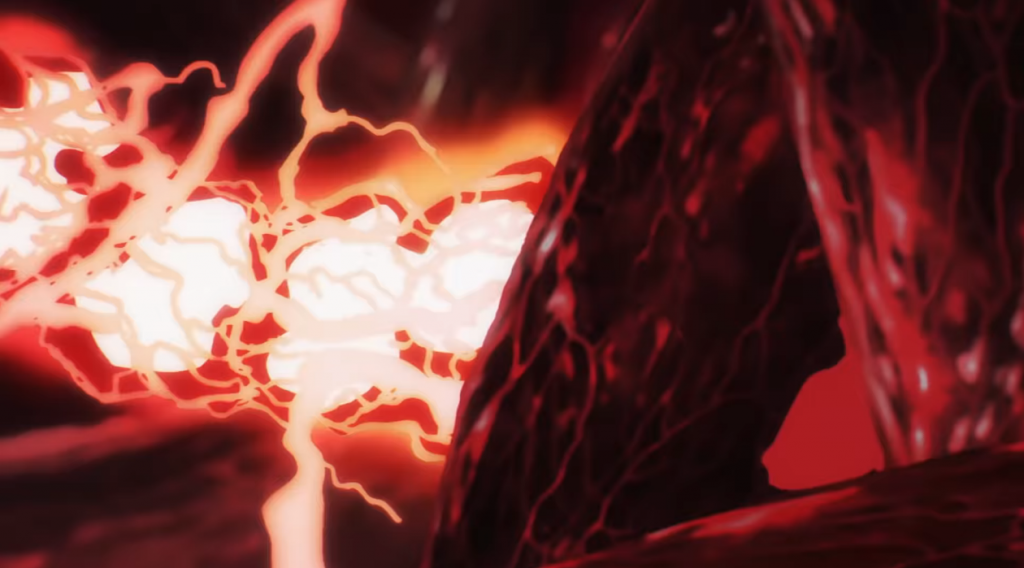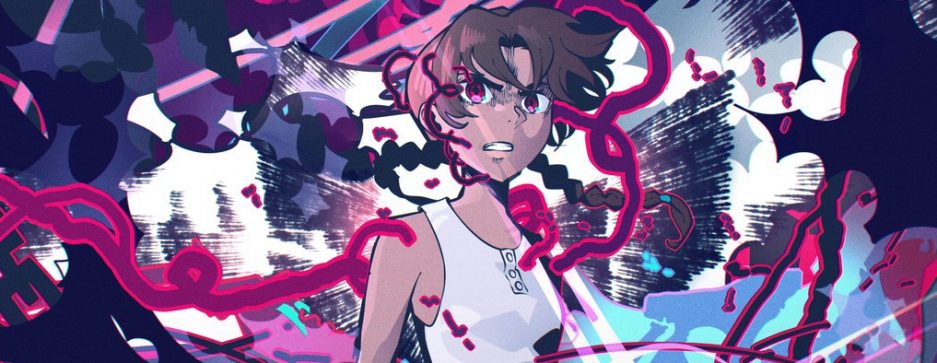While it has always existed, it’s clear that MV’s (music videos) led by anime creators and studios are in a boom. Those MVs are an incredible commercial tool as it provides a solid visual representation of whatever it happens to be promoting. Surely the best example of that is Rie Matsumoto’s MV for the 7th anniversary of Lotte, a… chocolate brand. Clicking at 19m views, there’s no doubt that this MV worked better than any traditional advertising could have.
But it wouldn’t be fair to describe those MVs as mere advertising for artists or brands. They tend to tell stories in a more ambitious and satisfying way than some TV animes or movies. Something that can be attributed to the creative freedom, as well as the shorter length, letting the staff take no compromises. Today I’ll go back to a few months ago to talk about a MV I found particularly (or so I thought as we’re now getting that kind of MVs every two weeks) enjoyable.
This Monster Strike MV, titled “Despair smashing girl ∞Amida” was made in order to promote a new character in the mobile game since apparently all reasons are good to make an ambitious music video! Clearly rooted in TV anime writing when it comes to how the story unfolds and the characters, the MV feels like a condensed version of that in a way. But it does it in a satisfying fashion and manages to bring all the good points of TV anime while being an experience on its own.
And you can surely attribute that to the team behind this MV! First, we have Daiki Harashina as director, character designer, storyboard, unit director and animation director. As you can tell, Harashina is the main culprit behind the quality of this MV. Which is really impressive considering he was still an inbetweener at Khara 4 years ago. Quite the rapid growth but it makes sense considering his talent and also his surroundings! That leads me to talking about the second main culprit behind the strength of this MV: animation producer Yuichiro Fukushi.
Producers aren’t really a hot topic, even in the sakuga community. It’s difficult to know what to attribute to them and while their jobs are essential to the production, you can’t really pinpoint something particular in the final product itself, like you would do with an animator or director. However, Yuichiro Fukushi is in that extremely small circles of producers who are consistently praised (others examples include Shota Umehara, Yuichi Fukushima, or more recently Yuichiro Kikuchi) and for good reasons. Fukushi’s productions are filled with artists of various styles and ages, and trusting young talents is surely his most important quality. Daiki Harashina and his partner in crime Keiichiro Saito both produced the best episodes of Boogiepop together and that was all that was needed for Fukushi to promote them to the director seat for smaller projects. And now he did it again by promoting Nobuhide Kariya to that same role for Azur Lane 3rd anniversary PV even though Kariya never directed an episode before. All of this while his main director, Shingo Natsume, is working on an original project!
So Harashina got the best crew to achieve his ambitions! You find his friend Keiichiro Saito of course but also the usual “Fukushi crew” with some industry stars such as Arifumi Imai, Toshiyuki Sato and many others.
The title is quite straightforward, it’s the story of a teenage girl, Amida, who fights monsters born from people’s despair. The infinity motif can be found everywhere in the MV. From the prop design, the cat design (the website insists on the fact it’s an alien but I’m suspecting the cat mafia is behind this), the cat tail and even the effects animation. While there are some meanings behind the sign, I wouldn’t go that far since it’s also a cool symbol to begin with. So let’s dissect the MV and discuss about the creative choices and the creators as well!
After some shots establishing the setting and main characters, we see a girl suddenly going toward the rails with Amida saving her by… entering into her. Well her spiritual world. The zipper thing is very indicative of a decision Harashina and the writing team took for the whole MV: subtlety was never an option!
I would like to think the blue birds symbolize twitter but that would be way too meme. Blue birds are more commonly associated with joy and happiness. They get eaten by the monster, you get it. I find the shot where she transforms to be fairly nice, since the monster is overwhelmed by the infinity sign, which stretches outside of the screen.
Toshiyuki Sato‘s goofy animation and expressions are a joy to watch but also gives us all the information we need about our heroine. She’s courageous but also clumsy, which describes pretty much your typical shonen protagonist. He also portrays pretty well how inexperienced she is from the way she runs and her stiff poses. But there’s also a case to be made about her instincts- making her go with the flow even if she gets owned a dozen times in the process. Like Hironori Tanaka, Toshiyuki Sato is a very prolific animator, regularly working with different crews. His animation can be wildly different depending on who he works with, but he always sure to nail whatever style he goes for. And if that wasn’t already enough, he can mix those different styles to bring new flavors to his animation. Here you have his goofy style with 150 funny expressions per second coupled with fast action and we even get some kanada-school effects.
The monster attacks Amida thanks a to an invisible phone throwing rocks with words on them. Connecting all the pieces tells you that the source of this girl’s despair is from people harassing her on social media. I think the MV does a great job filling the holes through its visuals.
Amida uses thatsacat as a weapon and annihilates the monster. And there’s no better animator than Takeshi Maenami to animate a finisher. Impressing fans and industry members alike, his understanding of timing makes all his cuts look incredibly cool and intense. In fact, Maenami is similar to the aforementioned Tanaka and Sato, in that he’s working with many different crew and studio and always doing high quality works. For someone who had his debut around 2 years ago, that’s beyond impressive. In fact he’s already an inspiration for some of his peers.
Happy end..? Well not really, sure the girl is saved but also left unconscious. Despite that, Amida continues fighting those entities while we notice the number of students is gradually lowering. The montage here is quite smart. The layout of the class is quite readable and while Amida isn’t really in the center of the room itself, our eyes are guided to her through the framing and her infinity-shaped hair.
Kanako Yoshida was the perfect fit for the two short action scenes. The montage is all about establishing a routine in a limited time and that also means packing information into each new cut. 2 seconds and you can get a satisfying action scene, full of intensity and speed. It’s achieved through bold smears and holding exaggerated key poses. It’s the kind of approach that necessitates to be skilled and also have a ton of confidence. Something that Yoshida surely doesn’t lack as she spent a lot of career at Dogakobo, a studio (once) renowned for its cartoony and fun character animation.
Amida is left all alone in the class. Her friend leaves first and she tries to reach for her with her hand. They’re next seen sitting waiting for the train. Despite the situation, Amida is still as cheerful as before while her friend is quietly listening. Blonde girl is drenched in obscurity with a very clear line. Not only is she in a dark spot but there’s a clear disconnect between her and Amida, indicating that she’s jealous of her. Again, it’s clear visual choices that make the narrative clear for the viewers, even on a subconscious level.
This shot frames the garbage bag as a way to foreshadow the following cuts and the reason why Amida is reluctant to leaving. The blonde girl has really gentle movement when she covers her mother. Something we can notice in the whole MV, her body language is extremely gentle and reserved. She doesn’t want to stand out too much, she’s consistently wearing a mask to not reveal her true feelings.
But suddenly she loses it. Snappy hand movement and tortured expression. That low-angle shot is particularly efficient as it’s a POV of the broken frame. It also lets Nobuhide Kariya animate the girl as she was stretching to the top, like her body is barely containing her (negative) emotions. Thankfully, Amida enters her body to fight the despair monster and beats the shit out of them! So she starts by breaking the mask *wink* and… discovers her friend’s true feelings. Paralyzed by that discovery, she gets beaten by the monster.
All hope seems lost but Amida remembers that moment when she was desparetly crying and her friend warmed her with her scarf. Thanks to her new determination, she manages to transform again and counter the monster’s beam.
Even in such a high quality MV, Norifumi Kugai managed to animate something worthy of being called a climax. His animation is incredibly dense, whether it’s the effects or the characters. As Nastume’s most trusted collaborator, Kugai has nothing to prove. His art is incredibly idiosyncratic, as seen with his ACCA designs, his episode of Boogiepop or even individual scenes on OPM. His fondness for lower frame count is a strength that few artists can claim. It makes his animation weighty and full of anticipation. It’s difficult to imagine a better choice for the climax of the MV.

The beam is especially impressive to me. Kugai animated several layers on top of each other, resulting in a supplement of information that triggers a sense of overwhelming power.

The fight ends kind of anti-climatically with a hug. Something totally intentional as it was the message all along. Amida beating her opponent through sheer violence was never framed as positive. She needed to understand the troubles of her classmates and helps them through kindness. Just like her friend helped her that day with some warmth. Surely not the kind of conclusion you would expect from such story but a more than welcome one.
